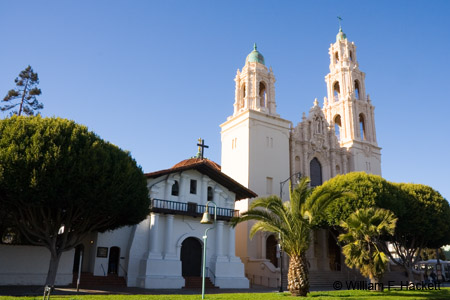Mission San Francisco de Asís (Dolores) and Basilica

I mentioned in an earlier blog entry that I would revisit the trip to Mission Dolores when the photos were ready, and I uploaded the photos to the site yesterday. I took the evening off to watch my Ohio State Buckeyes go down in ignominious defeat. Now, I am fully recovered.  As I mentioned on my “News / Blog” page:
As I mentioned on my “News / Blog” page:
“I uploaded 40 “existing-light” (almost always the case with me) photographs of Mission “Dolores” (Misión San Francisco de Asís; Mission Saint Francis of Assisi) and Mission Dolores Basilica to the Portfolio. The 30 of Mission Dolores (filenames begin with “Dolores…”) are in the California Missions section and the 10 of the interior of Mission Dolores Basilica (filenames begin with “SFBasilica…”) are in the San Francisco section.”
I left the white balance of interior photos “as shot” rather than correcting for tungsten light, since correction for tungsten left photos too “cool” (green in the case of the Mission  ). The additional illumination provided by stained-glass windows (yellows in the Mission; reds in the Basilica) on that very sunny day made the colors of the interiors “warm” and vibrant yellows/reds to the eye.
). The additional illumination provided by stained-glass windows (yellows in the Mission; reds in the Basilica) on that very sunny day made the colors of the interiors “warm” and vibrant yellows/reds to the eye.
Mission San Francisco de Asís (“La Misión Dolorosa“) is the oldest surviving structure in San Francisco. The Mission was founded on June 29, 1776 by Lieutenant José Joaquín Moraga and Father Francisco Palóu. The settlement was named for St. Francis of Assisi, the patron saint of San Francisco. The name of “Mission Dolores” refers to a nearby creek, Arroyo de Nuestra Señora de los Dolores or “Creek of Our Lady of Sorrows.”
The Mission building itself, completed in 1791 is the oldest intact Mission and is 114 feet long, 22 feet wide, and has adobe walls 4 feet thick. Original redwood logs, lashed together with rawhide, remain in place. Masses are still celebrated at the Mission. The ceiling has been repainted, but reflects the Ohlone Indian (Native American) designs that were originally painted with vegetable dyes. Access to the choir loft was originally by an outside staircase. The current spiral staircase is a later addition. The reredos, or decorative altar, came from San Blas, Mexico in 1796. The two (1, 2) side altars were brought to the Mission from Mexico in 1810. The colums of the side altars, which appear to be marble, are in fact wood. The gold leaf on the altars is basically the same as when it arrived.
Baptisms still occur at the Mission. The first of more than 28,000 baptisms that occurred during the Mission Period was two months before the Mission was officially established, and the records are still preserved. Within the Mission itself are other sights to see: relics, stained glass windows, the pulpit, and a mural. There are also four burial places marked within the Mission, those of: William Leidesdorff (an African-American pioneer businessman), the Noe family, Lieutenant Jose Joaquin Moraga (leader of the June 1776 expedition), and the Very Reverend Richard Carroll (the first pastor of Mission Dolores after San Francisco became an Archdiocese. There is also a museum.
Outside the Mission, you can see a fountain, and the Mission cemetery. Among the graves in the cemetery are those of the first “mayor” (Alcalde) of San Francisco, Don Francisco de Haro, and the first governor of Alta Calfornia, Don Luis Antonio Argüello.
From the walkway outside the Mission, you can enter the Mission Dolores Basilica. The present Basilica was constructed in 1918, after the original structure was destroyed in the San Francisco earthquake of 1906. In 1952, Pope Pius XII designed the church a Basilica, an honorary church of the Pope. The partially opened red-and-gold umbrella on the right side of the altar and the carved coat of arms with the papal insignia on the left are the marks of a Basilica. Pope John Paul II said Mass at the Basilica in his historic visit to the United States.
Inside the Basilica, you are immediately impressed with the size of the structure. The beautiful stained glass window at the rear of the church features Saint Francis of Assisi and the upper side windows feature angels. The lower side windows depict the 21 California Missions plus two in honor of Fathers Serra and Palóu. High above the altar, set against a sunburst pattern is a wood carving of Our Lady of Sorrows, and the Seven Sorrows of Mary are shown individually on the front of each of the two side balconies. Since we visited on December 26, the altar was decorated for Christmas. Views (1, 2) from the rear of the center aisle of the Basilica show the size of the church and the wonderful lighting through stained glass windows. Around the periphery of the church are 7 shrines.
I hope that the information above and the photos interest you in visiting the Mission and Basilica. The Mission is at 3321 Sixteenth Street, San Francisco, CA 94114, and there is also a web site. A $5 donation per person was requested when we visited the Mission, a very small price to pay for the experience.
-Bill at Cheshire Cat Photo™
You can view higher-resolution photos (*generally* 7-30 megabytes, compressed) at the Cheshire Cat Photo™ Pro Gallery on Shutterfly™, where you can also order prints and gifts decorated with the photos of your choice from the gallery. Apparel and other gifts decorated with some of our most popular photos can be ordered from the Cheshire Cat Photo™ Store on CafePress®.







